[This article was first published in April, 2022, and updated with new content and photos on November 2nd, 2023.]
Updated March 2024.
I have been secretly hoping that Leena and Raj would suggest I write about Pelikans, so I was thrilled when Raj messaged me, "I think the next topic can be the Pelikan pens." I love Pelikans, although I hadn't personally used the larger models, and I was eager to be able to explore them in depth. I own a gorgeous White Tortoise M400 and the mysterious looking Petrol-Marbled special edition M205, and I've probably spent more time than I should gazing longingly into the Pelikan display case at the store, wishing I had the money for some of the other classic models. I knew I would enjoy this topic, but I never imagined what writing with the spectacular M1000 nib would be like, nor was I fully aware of the amazing amount of variety in the entry-level M200 collection. But first, some background...
Pelikan History
Pelikan began in 1838 as an ink company founded by Carl Hornemann in Hanover, Germany, and was purchased from Hornemann in 1871 by Günther Wagner, who registered the pelican as one of the very first trademarks in Germany, in 1879. The pelican he used was adopted from his family crest. In 1884, Lewis Edison Waterman patented a fountain pen, and a market began to emerge for these new pens, which were much more convenient than the older dip pens. Before too long, Günther Wagner started producing inks for fountain pens.
 [I borrowed this book from our Pelikan display at the store. We no longer stock it, but we have the Pelikan: The Brand 175th anniversary collectors' book available for Pelikan lovers. This sumptuously illustrated coffee table book is full of beautiful artwork, including the poster that inspired the new Glauco Cambon M600, along with historical letters from Günther Wagner.]
[I borrowed this book from our Pelikan display at the store. We no longer stock it, but we have the Pelikan: The Brand 175th anniversary collectors' book available for Pelikan lovers. This sumptuously illustrated coffee table book is full of beautiful artwork, including the poster that inspired the new Glauco Cambon M600, along with historical letters from Günther Wagner.]

Until the late 1920s, fountain pens filled using pressure and lever mechanisms or an eyedropper, but they could only hold a small amount of ink and could be very messy. In 1929, Pelikan introduced their revolutionary new filling mechanism with a differential spindle gear. It was based on Günther Wagner's purchase of patents by Hungarian engineer Theodor Kovacs. This trendsetting piston filler, the "transparent Pelikan fountain pen" was launched the same year and was an immediate sensation. This pen had a translucent ink container, which made it easier to monitor the ink capacity. The jade green translucent ink window is still used in today's black Pelikan pen models.

In 1950, the Pelikan 400 model was launched. This fountain pen had the classic translucent green and black striped celluloid barrel and looked virtually identical to the modern M400 Pelikan pens that were relaunched in 1982 with some changes to the ink feed and piston mechanism. Although Pelikan has since introduced many other variations, this translucent green and black striped color scheme is iconic for the brand, along with the famous beak shaped clip.

Pelikan Classics
The most classic Pelikan pens are the M1000, M800, M600, M400, and M200 series. These pens all have the same traditional shape that was first introduced in 1950. This type of Pelikan (with the exception of the steel-nibbed M200 pens) is known as the Souverän, which means "sovereign" in German.
 (Left to right: M1000 in Black, M800 in Black/Green, M605 Stresemann, M400 in Black/Red, and M205 Petrol-Marbled. The "5" endings are used for pens with silver colored trim.)
(Left to right: M1000 in Black, M800 in Black/Green, M605 Stresemann, M400 in Black/Red, and M205 Petrol-Marbled. The "5" endings are used for pens with silver colored trim.)
The striped material that forms the distinctive barrels in the Souverän range is cellulose acetate made from a cotton base using a formula developed specially for Pelikan. Pelikan manufactures a striped bolt, slowly builds up the layers over months, bends them to tailored plates, and contour grinds and shapes them using a natural diamond. Each of the stripes has an individual radiance. They are quite beautiful, and give a great deal of depth and a complex vintage look to the barrel of the pen. Traditionally, pens with the striped motif have been translucent--if you hold a standard Souverän up in a well-lit place, light shines through the colored stripes and you can judge how much ink you have in your pen.
It was recently announced that, going forward, Pelikan is changing the material of the striped cellulose acetate, so that the currently translucent parts will be opaque in newer pens. This is due to how difficult it is getting the materials necessary for the manufacturing process in the age of COVID-19. So, if you love the classic translucent Pelikan barrel, now is a good time to snag a Pelikan with that barrel while you still can. Some of Pelikan's recent special editions already have the opaque look, as do their current Souverän rollerballs, ballpoints, and pencils. There is an article on the excellent site The Pelikan Perch which discusses this change in depth.
Pelikan Nibs
The M1000, M800, and M600 series each have their own individual body size and nib size, while the M400 and M200 series are the same size and are able to swap nibs. The difference between these two is that the M200 series has a steel nib and less fancy trim. M1000 and M800 have 18k gold nibs, while M600 and M400 are 14k gold.

One fascinating thing that I learned when I was researching before I bought my first Pelikan is that some models can also fit vintage Pelikan nibs! Indy-Pen-Dance has a handy chart showing the different interchangeable nib sizes if you are interested in delving deeper into the possibilities of combining modern and vintage pens. I have never done this, but I always thought having this potential was one of the especially cool things about Pelikans, as vintage pens' nibs can be quite different from modern ones, and many pen aficionados find them very desirable.
The Piston Mechanism
The other special thing about Pelikan pens is their piston filling mechanism. The mechanism works the same now as it did when Pelikan introduced this new invention in 1929. I was a little nervous about trying it before I bought my first Pelikan, but it's actually extremely simple to use and one of the things I love most about my Pelikan pens is how easy they are to fill and clean.
To fill the pen, first gently twist the knob at the end of the pen counter-clockwise (to the left) until it stops. This moves the filling mechanism forward, toward the nib. You can actually see how this works with a transparent model like the Golden Beryl M200.

Next, simply submerge the nib in a bottle of ink and smoothly turn the knob in the reverse direction to draw the ink into the ink reservoir. This moves the piston away from the nib. The piston movement creates a vacuum that draws the ink into the fountain pen. You can repeat this process if the pen doesn't fill completely the first time. (You also don't have to fill it completely, if you don't need an entire fill of that ink color and don't want to waste ink.)
If you have a translucent Pelikan, you can hold the pen up to the light to see both the mechanism and how much ink is in the reservoir.
 (This is my own personal pen and it's an older model that we don't carry, but I didn't want to fill one of our store pens with ink!)
(This is my own personal pen and it's an older model that we don't carry, but I didn't want to fill one of our store pens with ink!)
Here's another tip: the Pelikan book suggests that you should allow three to five drops of ink to drip back into the bottle after filling your pen. This allows excess ink to flow back out of the ink regulator, and too-wet writing and ink dripping into the cap will be avoided.
Turn the nib upright and slowly turn the knob to release any remaining air from the pen. The knob should come to a stop and be flush with the pen. If there is any excess ink on the grip, you can wipe it off with a soft cloth or paper towel.
Cleaning the pen is just as easy! Simply submerge the nib in a glass of water and turn the knob slowly in both directions to draw clean water into the pen and dispel the remaining ink and water in the ink reservoir. Repeat this process until the water being dispelled from the pen runs clean. It only takes a minute or two, and I love how easy it is to tell when the pen is fully clean! You can also easily unscrew the nib and remove it from the pen and rinse it under running water or soak it in water to assist the cleaning process if you need to. I like using my M205 for testing inks because cleaning is so quick and thorough.

Writing with the Pelikans
Yes, I love looking at Pelikans, thinking about Pelikans, filing Pelikans, and cleaning Pelikans, but how about writing with Pelikans? These pens are super smooth, with lots of variety to please different tastes. I was astounded when I tried the different pens I brought home and compared both the different pen sizes and nib sizes.
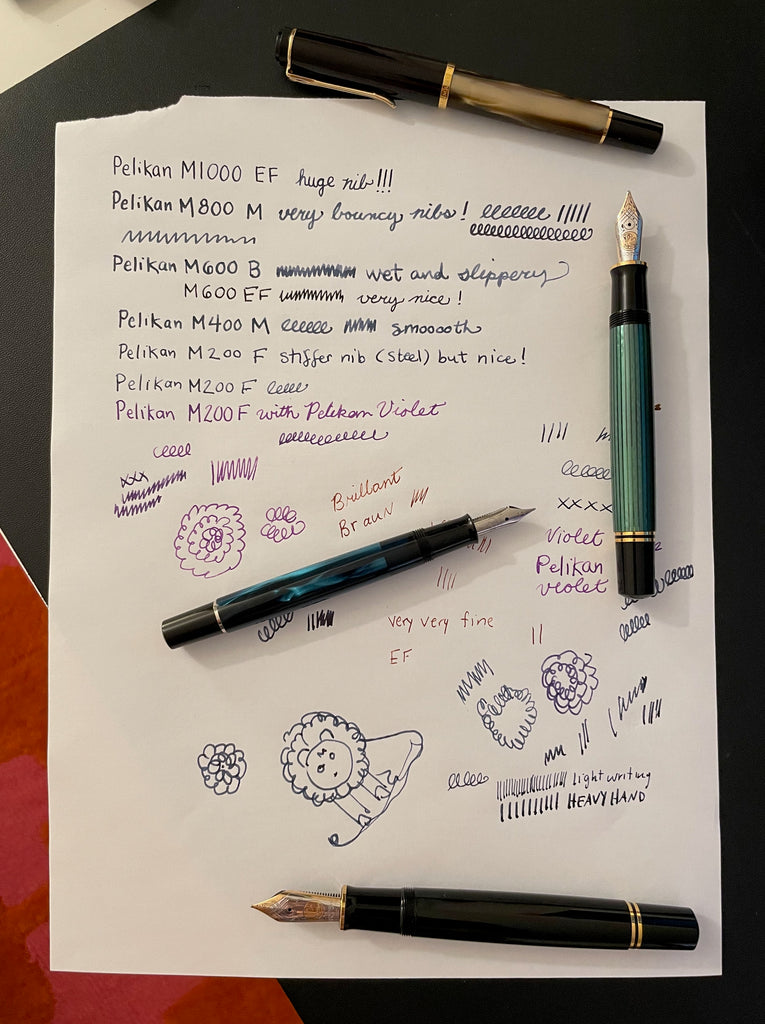
I found the broad nibs a little too wet and thick, but they were my dad's favorite! My mom, on the other hand, preferred the extra fine nibs across the board. I enjoyed different aspects of all the sizes. I sampled the pens on Rhodia paper.
There was a big difference between the EF nib on the M1000, the M600, and the M200. The large 18k gold nib on the M1000 put down a lot more ink, and although it was able to write fairly fine, it was more similar to a Japanese medium fine, but with the capability of flexing and writing with a line that was almost twice as thick! It felt a little scary, but also amazing! (Note that the "light writing" and "heavy hand" part near the bottom of the previous photo was also done with the M1000.)

Here I used the same ink for all three pens--Pelikan Edelstein Tanzanite. Note that Pelikans are very wet writers, so Pelikan ink is on the dry side. They behaved perfectly with this ink. Keep in mind that the writing might be even thicker with different ink, though! This sample is on Tomoe River paper.
I found the EF M200 a little too fine for my taste, but my F M205 is perfect for me. The steel nibbed M200 series pens write thinner than the Souverän pens, and their nibs are much stiffer, but are still nice and aren't scratchy.
Souverän M1000
Of all the different models, the one that impressed me the most was the Souverän M1000. This pen is much too large for me, but it's a truly remarkable pen. The nib is not advertised as being a flex or semi-flex nib, but due to its sheer size and the softness of the 18k gold, it produces an amazing amount of line variation.

Please be careful with this pen so that you do not spring the beautiful huge nib!


As I said, this is quite a substantial pen, and really too large for my hands, but I still can't help loving it. Although it's fairly heavy just due to the size, the balance is perfect. While I was in the store, I compared the size to a few other exceptional large pens. Here, side by side, are a Parker Duofold Centennial, the Pelikan M1000 Souverän, a Sailor Professional Gear King of Pens, and a Montblanc Meisterstuck 149. The Pelikan has the largest nib, and I also think it's the most beautiful!
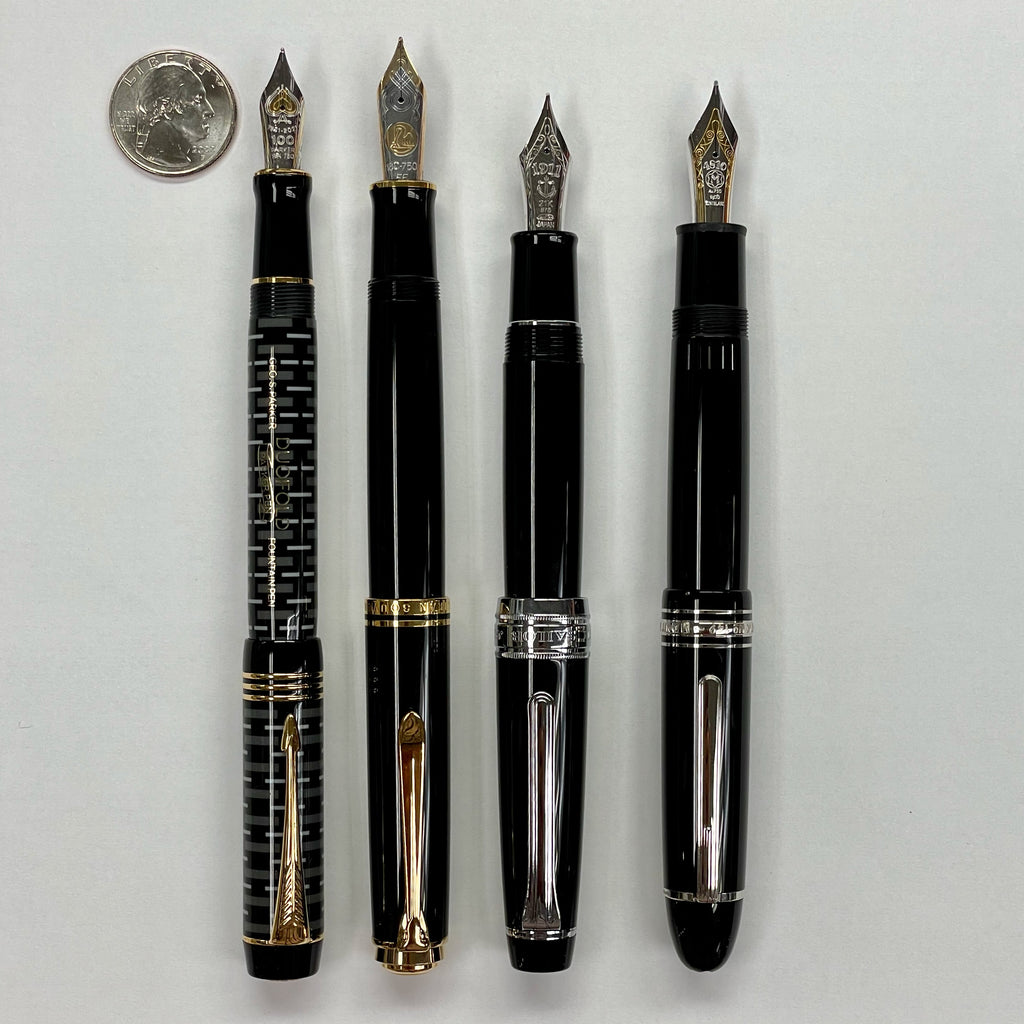
From the Largest... to the Smallest
What if you don't want the large and very expensive M1000? Well, that's why there are three other sizes! When I had my father try the pens, his favorite size was actually the same as mine--the smallest one! The M400 and M200 models are sized like vintage pens and may seem small at first if you are used to larger modern pens, but they can be very comfortable for both men and women and are also the most portable and lightest. (Plus there's that neat thing I mentioned earlier about being able to use vintage nibs in them or swap the steel M200 series nib for a gold one.)
What I like most about the M200 series (other than the lower price) is that it comes in so many cool barrel designs that aren't available on the more expensive pens. Check out this sampling of M200 series pens we have in stock right now in the store:
 (Top to bottom: Golden Beryl, Brown Marbled, Petrol-Marbled, Pastel Green, and Moonstone.)
(Top to bottom: Golden Beryl, Brown Marbled, Petrol-Marbled, Pastel Green, and Moonstone.)
All of these pens are breathtaking in person and I especially love how the look of the barrels changes depending on lighting. You really have to experience it in person to get the full effect, but here are some photos to give you an idea of their beauty.



Golden Beryl and Moonstone are both available as beautiful sets with matching Pelikan Edelstein ink, and the sets are an amazing value. We have them on sale while supplies last.
When I saw the Moonstone pen on display in the store, I thought it was a little boring, but when I brought it home and took it outside in the sunlight, I discovered this pen's secret. Indoors, it looks grey and mysterious, but the sun reveals that it's actually full of brilliant sparkles!

The Golden Beryl set is also breathtaking in the sunlight, and the desirable Golden Beryl ink (Pelikan's Ink of the Year from 2021) that accompanies it is sold out pretty much everywhere if you try to buy a bottle individually.

Here are the two pens together. So extreme in bright sun!

...and Everything in Between
All of the Pelikan sizes have their charms, and each Pelikan lover will have his or her own favorites. I found it hard to choose just a few pens to bring home, since I loved them all and wanted to give a full representation of the different colors and models. Pelikan devotees often end up developing what they call a "flock," and affectionately refer to their pens as "birds." Here are a few more beautiful birds preening in the soft light of spring.

 M605 Stresemann. This classy black and grey striped model was named for the suit style made popular by the foreign minister of the Weimar Republic, Gustav Stresemann.
M605 Stresemann. This classy black and grey striped model was named for the suit style made popular by the foreign minister of the Weimar Republic, Gustav Stresemann.
 (M605 Green-White. No longer in stock, sorry!)
(M605 Green-White. No longer in stock, sorry!)
 M405 Silver-White. (I can't decide whether I like Pelikans best in black or in white!)
M405 Silver-White. (I can't decide whether I like Pelikans best in black or in white!)
Here are the classic Souverän M1000, M800, and M400 together with the ink I used in my writing samples.

And this is what they call a FLOCK.
Update!
In late October, 2023, we received about twenty different really interesting retired Pelikans, adding still more kindling to my Pelikan passion. These discontinued colors are no longer being produced, so we will only have them while supplies last, but some of them are extremely beautiful and desirable colors, including Tortoiseshell Red, Blue Dunes, Cafe Creme, Burnt Orange, and more. We are even able to offer them at 20% off! I am so tempted to get another Pelikan. I have wanted a Tortoiseshell Red M600 for a long time, and when I saw the pretty Tortoiseshell Brown M400, it took my breath away. We even have some of my beloved Petrol-Marbled M205, which went out of stock shortly after I bought mine in January, 2022.
I decided to update this article by making a few edits, fixing broken links, and adding photos of some of my favorites from the flock of retired birds we received. I didn't take photos of every pen on the list, so be sure to check out the others, too. You may see the long-lost Pelikan of your dreams! If you see one you like, but are looking for a different nib size, please give us a call or email us. We will try to accommodate you with a nib-switch, if possible.

The little flock I decided to bring home, snug in my Girologio 24-Zip pen case, includes: Burnt Orange M800, Blue Dunes M805, Tortoiseshell Red M600, Vibrant Orange M600, Smoky Quartz M200, Demonstrator M205, Gold-Marbled M200, Cognac M200, Cafe Creme M200, Petrol-Marbled M205, and Bright Red M101N, which is a vintage-looking gold nib pen in a historical shape derived from a design dating back to the 1930s.

The M101N comes in a deluxe box that includes a beautiful vintage-style bottle of Pelikan 4001 Königsblau (Royal Blue) ink. This compact pen is shorter than the M200 or M400 series when capped, but longer when the cap is posted. Its nib looks a little different, but is interchangeable with M200 and M400 series nibs, as well as the M120 model's nib.

Blue Dunes is stunning, and blue devotees will also love Blue o' blue, Marine Blue, and the newer Pastel Blue.

Every time I see a photo of a Tortoiseshell Red M600 online, I want one. Now that I've seen it in person, I want it even more. The deep orangey-red tones are incredible!

Burnt Orange, Smoky Quartz, and Cognac are so autumnal. Smoky Quartz is the darker of the two warm brown demonstrators.

Vibrant Orange seems to almost catch fire in the late-afternoon sun!

The clear Demonstrator M205 and glowing-warm Gold-Marbled M200 make a lovely contrasting pair. (Gold-Marbled reminds me of my White Tortoise M400, but it's a lot less expensive.)

And, I'll never turn down a good Kaffeepause. Cafe Creme is such a yummy-looking cream and coffee brown.

I'm still happy with my two little birds, for now. But.... that Green Stripe Souverän sets the standard for a reason.

-Laura P.
2024 Update: A Modern Twist on a Classic
For those seeking a more contemporary Pelikan experience, the recent arrival of the Pelikan Classic M200 Fountain Pen in Orange Delight (Special Edition) is a cause for celebration. Released in 2024, this pen embodies the spirit of innovation while staying true to Pelikan's heritage.
The translucent orange resin, a vibrant departure from traditional Pelikan colors, offers a glimpse into the inner workings of the pen, adding a touch of intrigue. The gold-plated accents and smooth steel nib remain hallmarks of Pelikan quality, ensuring both beauty and functionality. The piston filling mechanism, beloved by Pelikan enthusiasts, guarantees a reliable and enjoyable writing experience.
This delightful addition to the Pelikan family is sure to tempt even the most discerning collector. Don't miss your chance to add a touch of modern flair to your Pelikan collection!
I love comments on my blog! Please leave comments if you like the articles, and, if you have any questions about this article, or any of the other blog articles, you can e-mail support@penboutique.com. Thank you!






 (
( (
(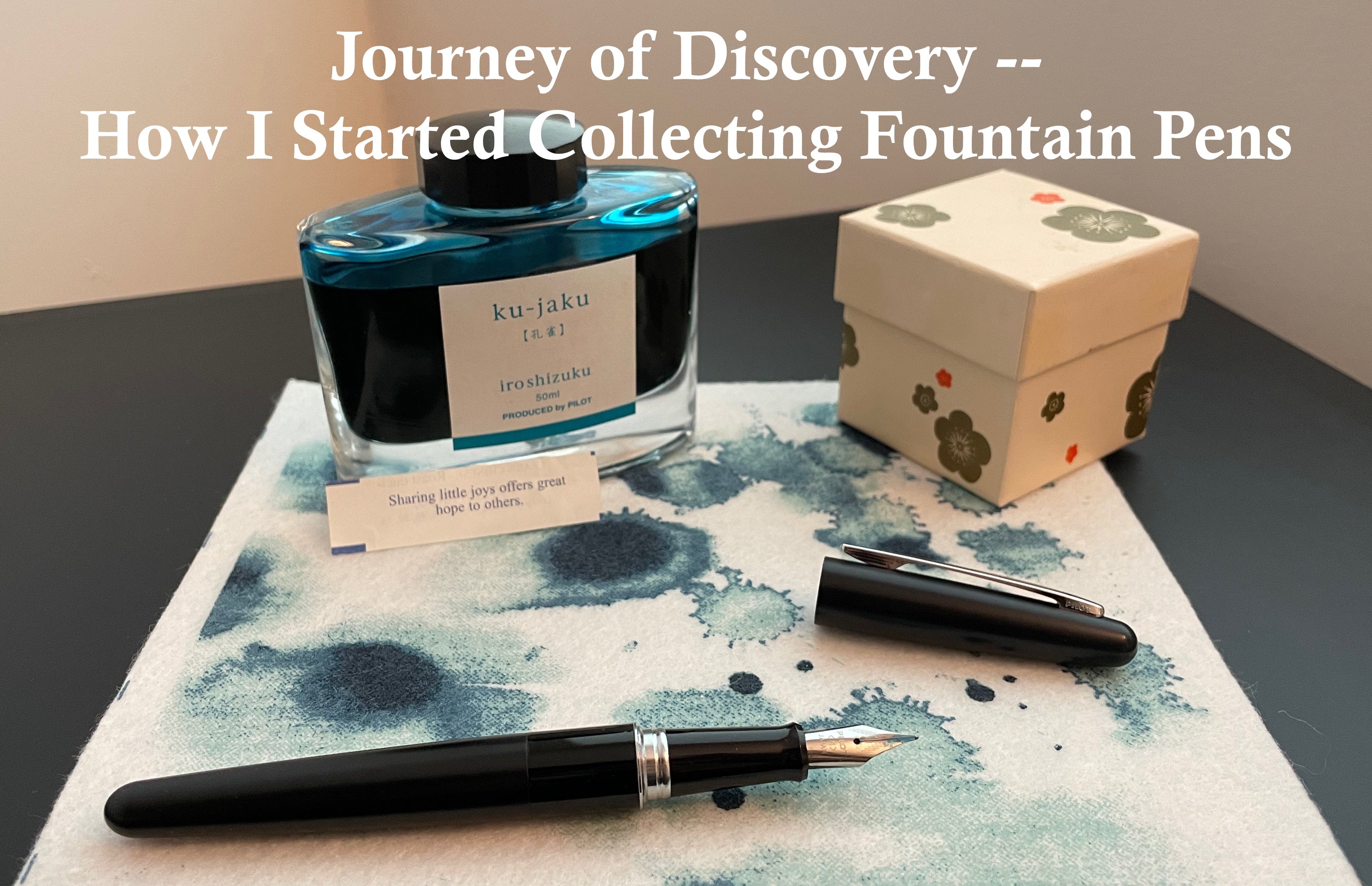
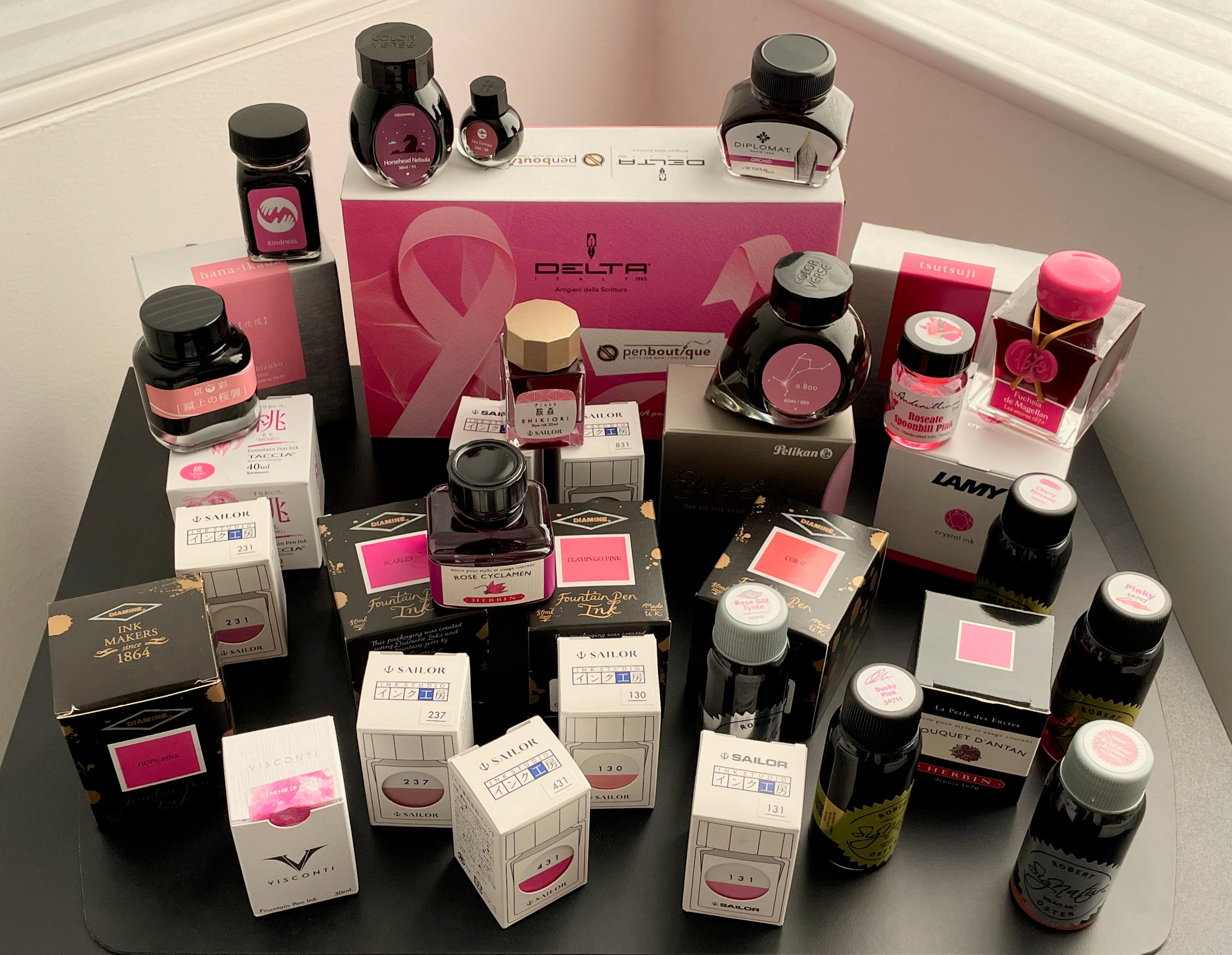

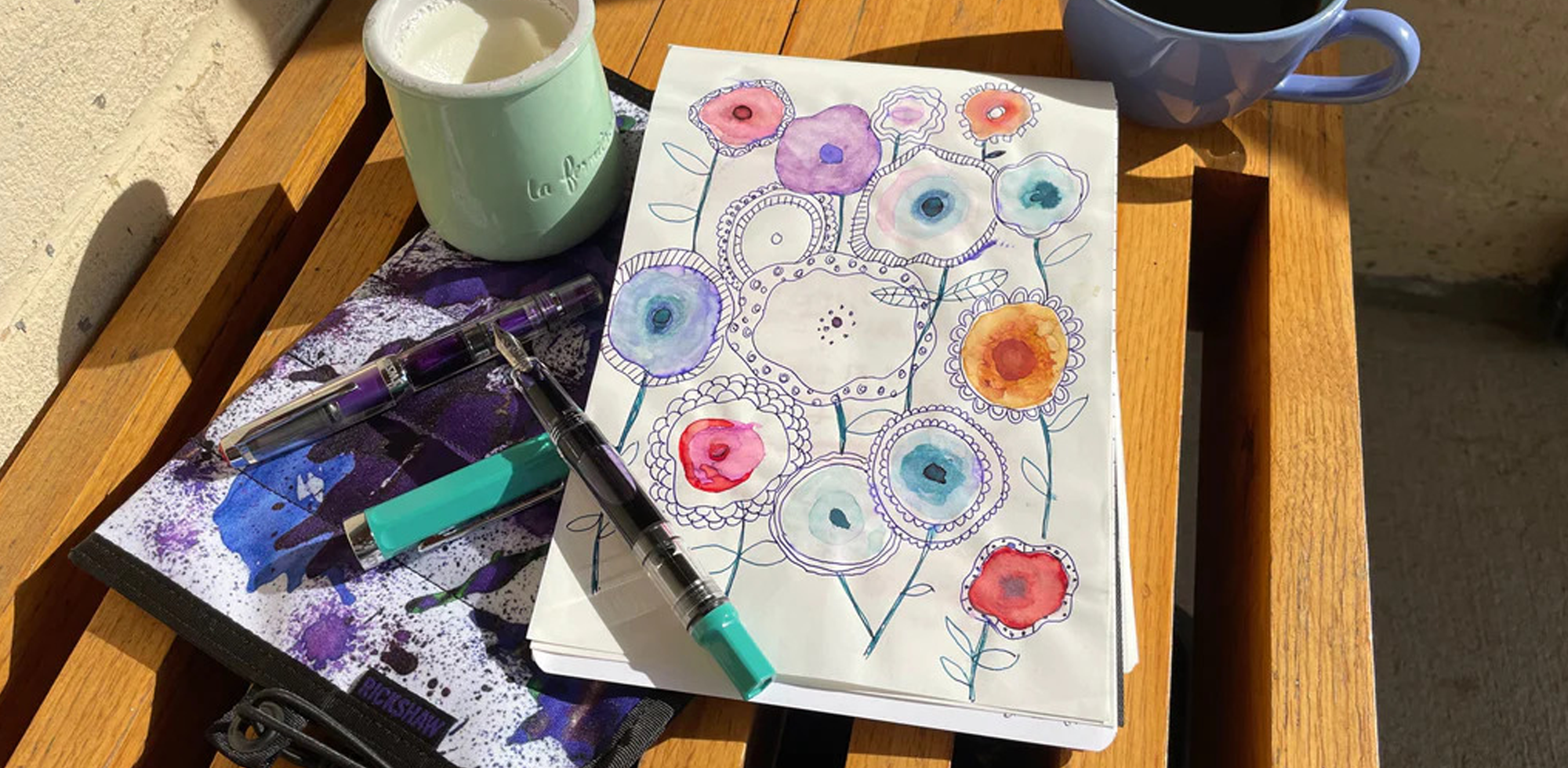
36 comments